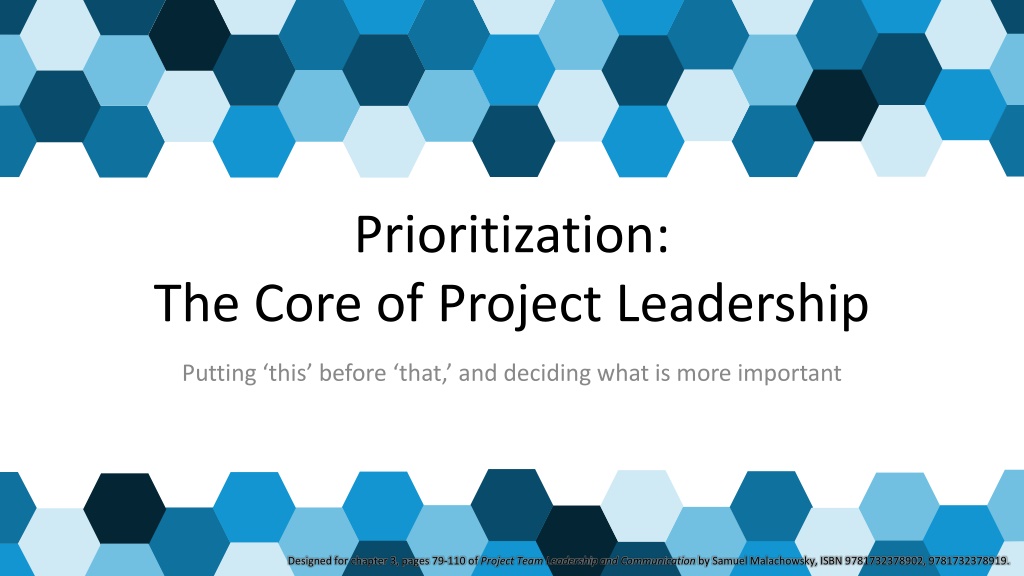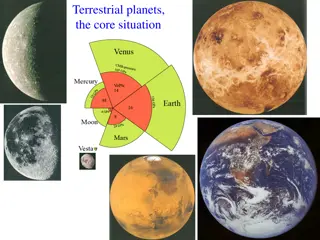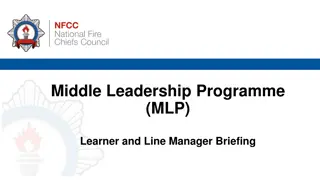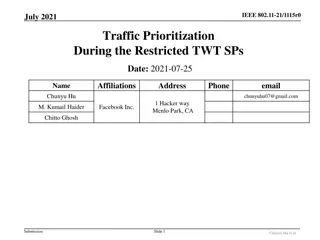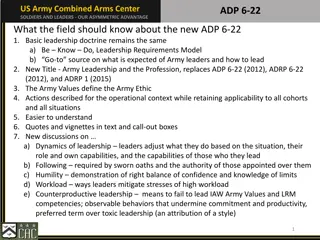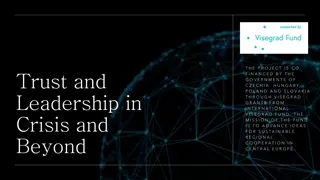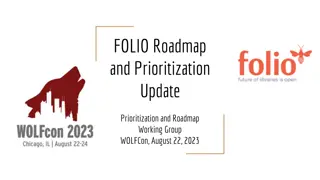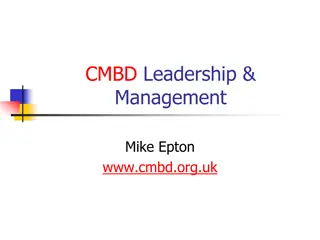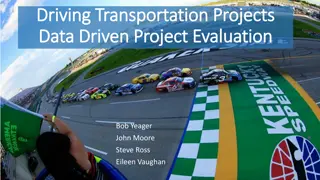Prioritization: The Core of Project Leadership
Prioritization is essential in project leadership, involving putting tasks in order of importance. Planning, estimating, and scheduling are key steps before executing the work. Estimation techniques such as expert judgment, group consensus, top-down, bottom-up, and comparison/analogy help in determining project timelines and resource allocation.
Download Presentation

Please find below an Image/Link to download the presentation.
The content on the website is provided AS IS for your information and personal use only. It may not be sold, licensed, or shared on other websites without obtaining consent from the author.If you encounter any issues during the download, it is possible that the publisher has removed the file from their server.
You are allowed to download the files provided on this website for personal or commercial use, subject to the condition that they are used lawfully. All files are the property of their respective owners.
The content on the website is provided AS IS for your information and personal use only. It may not be sold, licensed, or shared on other websites without obtaining consent from the author.
E N D
Presentation Transcript
Prioritization: The Core of Project Leadership Putting this before that, and deciding what is more important Designed for chapter 3, pages 79-110 of Project Team Leadership and Communication by Samuel Malachowsky, ISBN 9781732378902, 9781732378919.
Planning and Prioritizing Project Work Before work can be completed, three basic steps must take place: Planning takes place early in the project, and determines objectives to be completed, resources available, etc. Estimating is the process of determining how long or how many resources each planned element will take Schedulingis the calandarization of estimated work Once the work begins (execution of plans): Tracking must occur, comparing actual results with plans, estimates, and schedules If changes occur or results vary from plans, repeat the steps Diagram: Malachowsky, Samuel. Project Team Leadership and Communication. Lintwood Press. 2018. p. 88.
Estimation Techniques (1 of 3) Expert Judgement: experience is used to estimate The basis for all other techniques Strengths: expert lends credibility to estimate Weaknesses: one person s expertise may fail Group Consensus: various techniques are used to poll the group and reach consensus Strengths: group participation and buy-in Weaknesses: bias and cultural issues manifest Diagrams: Malachowsky, Samuel. Project Team Leadership and Communication. Lintwood Press. 2018. p. 80, 82.
Estimation Techniques (2 of 3) Top-Down: large units estimated then divided up Strengths: usable when less detail is known Weaknesses: inaccurate if major sections of the project aren t considered Bottom-Up: small units estimated then added together Strengths: can be quite precise if used properly Weaknesses: more time consuming than other techniques, changes to items can impact greatly Diagrams: Malachowsky, Samuel. Project Team Leadership and Communication. Lintwood Press. 2018. p. 81.
Estimation Techniques (3 of 3) Comparison or Analogy: projects (or components) are compared to previous work Strengths: based on actual results, increasing credibility and potentially accuracy Weaknesses: all projects are unique, may be difficult to find comparisons, data may not exist Other Methods: mathematical/statistical models, focusing on size rather than time, or industry-specific methods Diagrams: Malachowsky, Samuel. Project Team Leadership and Communication. Lintwood Press. 2018. p. 81, 82.
Estimates vs. Commitments All parties must be careful not to confuse estimates with commitments Commitments: Are deadlines real or arbitrary? Estimates: Presentation can be important: Ranges (6-8 Months), plus/minus qualifiers (7 Weeks +/ 1 Week), and Confidence factors (4 weeks: 30% chance, 5 weeks: 50% chance) can be helpful Don t confuse estimation with scheduling, which sets actual dates Diagrams: Malachowsky, Samuel. Project Team Leadership and Communication. Lintwood Press. 2018. p. 84.
Accuracy vs. Precision Accuracy is how true a value is 4-6 is accurate if the actual # is 5.5 Precision is how exact a value is 4-6 is less precise than 4.5-5.5 Within a project communications should always be as accurate as possible (especially in estimating) Because uncertainty is high at the beginning of a project, the only way to be accurate is to be less precise As the project progresses, we can be more and more precise while remaining accurate throughout (ranges get smaller and smaller) Diagram: Malachowsky, Samuel. Project Team Leadership and Communication. Lintwood Press. 2018. p. 86. McConnell, Steve. Software Project Survival Guide: how to be sure your first important project isn t your last. Redmond, WA: Microsoft Press. p. 31. 1998.
Organizing Tasks: The Work Breakdown Structure Organizes elements with sub- numbers. 1.2.3 is part of 1.2 Two types: product & process Product divides by components Process divides by activities/tasks Can be built top down, bottom-up, or rolling-wave A good way to organize brain- storming efforts early in the project Sequencing of tasks or components isn t needed until later in scheduling efforts Diagrams: Malachowsky, Samuel. Project Team Leadership and Communication. Lintwood Press. 2018. p. 88. Project Management Institute. A Guide to the Project Management Body of Knowledge Fifth Edition. Project Management Institute Inc. p. 125-132. 2013.
The One-to-Two Rule How do you know when you ve divided tasks into small enough chunks ? If tasks are too large, it becomes difficult to track progress If tasks are too small, time is wasted micromanaging the project Optimize with The One-to-Two Rule, which states that tasks have been divided enough when each requires 1-2 resources 1-2 weeks to complete it Diagram: Malachowsky, Samuel. Project Team Leadership and Communication. Lintwood Press. 2018.
Sequencing and Scheduling Tasks Predecessors or dependencies are determined for all tasks Using this information, a precedence diagram is created The longest path, called the critical path, determines project length Slack time, the ability to delay starting without impacting the schedule, is available to some tasks which are not on the critical path Tasks are then calandarized, with actual dates based on resources available Diagrams: Malachowsky, Samuel. Project Team Leadership and Communication. Lintwood Press. 2018. p. 89, 90.
Tracking Progress A main concern of project tracking is visibility. Often, the team isn t aware of how far along they are due to long phases Project Visibility is often only achieved when phases are started or completed Diagram: Malachowsky, Samuel. Project Team Leadership and Communication. Lintwood Press. 2018. p. 94. McConnell, Steve. Rapid Development: Taming Wild Software Schedules. Redmond, WA: Microsoft Press. p. 57. 1996.
Tracking Earned Value Tasks or groups of tasks are often tracked with little granularity (large chunks instead of small) and simple not-started / started / complete progress reporting By giving each task a relative weight and assigning earned value to sub-tasks, the percentage of progress can be calculated (example: 660/2100=31% complete) Calculated earned value can be compared to the time or resources expended Diagrams: Malachowsky, Samuel. Project Team Leadership and Communication. Lintwood Press. 2018. p. 95.
Scheduling/Tracking Tools and Visualizations Milestone Charts list major points in time, or milestones, such as phases ending Gantt Charts provide an easy-to-understand visualization of the schedule and progress Many software packages and online tools are specifically designed for managing projects Diagrams: Malachowsky, Samuel. Project Team Leadership and Communication. Lintwood Press. 2018. p. 92, 96.
Risk Identification Risks are problems that haven t happened yet They re uncertain ( 0%<100% chance) They would result in a loss to the project (typically time or resources) The project can do something to manage them (within the scope of the project) Everyone should be involved in identifying risks, and they come from multiple places The team, stakeholders, organization, environment, finances, etc. Use SWOT analysis to identify risks: Internal weaknesses and external threats represent potential risks Diagram: Malachowsky, Samuel. Project Team Leadership and Communication. Lintwood Press. 2018. p. 98.
Risk Analysis Risks may or may not occur, and their impact on the project is variable Project teams estimate the probability of the risk as well as possible Very Unlikely (15%), Unlikely (30%), Neutral (50%), Likely (70%) Very Likely (85%) The potential impact of the risk is also estimated Loss of 2 weeks, additional expenditures of $3,800, etc. These numbers are multiplied to calculate risk exposure. (30% X 2 weeks = 0.6 weeks) Identified risks and their probabilities, impacts, and exposures are recorded in a risk register Risks with the highest risk exposure are placed at the top of the list and are highest priority Diagram: Malachowsky, Samuel. Project Team Leadership and Communication. Lintwood Press. 2018. p. 100.
Risk Response Risk mitigation or management: an intentional response to an identified risk Avoid remove the risky part of the project Learn more acquire additional knowledge on how to deal with the risk (research, prototype, etc.) Transfer move the risk to a less vital part of the schedule (off the critical path) or to another entity more capable of handling it (a trained team, purchase insurance, etc.) Accept Accept the risk as is, but formulate a way of lessening its impact or handling it if it occurs (a mitigation strategy) Risk responses are reflected in the project schedule/budget Total risk exposure is added to the final schedule length Diagram: Malachowsky, Samuel. Project Team Leadership and Communication. Lintwood Press. 2018. p. 101.
Prioritizing Stakeholders Stakeholders are people who can affect or are affected by the execution or outcome of a project. Everyone should be involved in identifying them Stakeholders can be groups Once identified, they should be analyzed High or low power, or ability to affect the project High or low interest, or how they re affected by the projects positive or negative outcome All information should be recorded/tracked in a stakeholder register ID Name Title Info Notes Power Interest Strategy 1 Casey Johnson Sales Lead cjohnson@co.com Initiated the contract Low High Keep Informed 2 Jordan Baker Team Specialist 555-1532 High High Manage Closely Diagram: Malachowsky, Samuel. Project Team Leadership and Communication. Lintwood Press. 2018. p. 104. Project Management Institute. A Guide to the Project Management Body of Knowledge Fifth Edition. Project Management Institute Inc. p. 395-397. 2013.
Summary and Conclusions Project work requires planning, estimating, scheduling, and tracking Estimating judges how long project work will take There are several techniques (top-down, bottom-up, analogy, etc.) Teams must provide clarity between and estimate and a commitment Early estimations should be imprecise (ranges, etc.) to remain accurate In order to properly schedule tasks, they must first be sequenced Work Breakdown Structures assist in dividing work into smaller, estimate-able tasks Tasks have dependencies/precedence which must be accounted for in final schedule Use visualizations and tools such as milestone charts, Gantt charts, and precedence diagrams Tracking after the project begins is what makes scheduling efforts worth it Risks, especially those affecting schedule, can be identified (with SWOT analysis), analyzed (calculating risk exposure), and responded to (mitigation and tracking) Stakeholder prioritization starts with identification, then analyzes and formulates strategies
